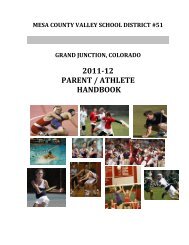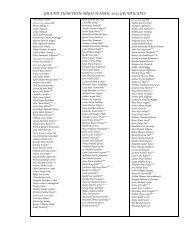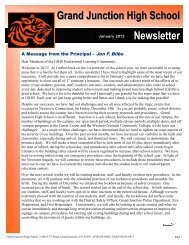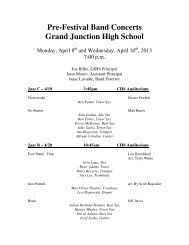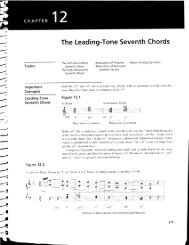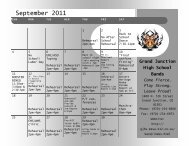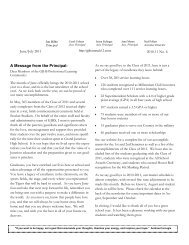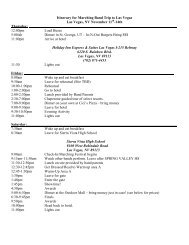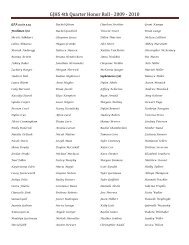Create successful ePaper yourself
Turn your PDF publications into a flip-book with our unique Google optimized e-Paper software.
t_:<br />
r t<br />
.'-- .<br />
t 7<br />
Y-t<br />
l - s<br />
?'<br />
14<br />
a' 7t r l<br />
t-t;<br />
I t<br />
-<br />
4<br />
,.<br />
<strong>t4</strong><br />
l4<br />
l-t<br />
*l<br />
J<br />
t<br />
<strong>t4</strong><br />
Er*,<br />
Topics<br />
lmportant<br />
Concepts<br />
The Motive<br />
Melodic Motives<br />
Figure<br />
6.1<br />
Melodic Organtzation<br />
Motive<br />
Melodic Motive<br />
Rhythmic Motive<br />
5eguence<br />
Sequence Segment<br />
Real Sequence<br />
Tonal Sequence<br />
Modified Sequence<br />
Rirnskv-Korsakoff: Scheherazade, op. 35.<br />
6<br />
.1,) ? .<br />
'a r)<br />
-<br />
a<br />
M"t""<br />
-' lri. [)u rtlunus.<br />
\lotive<br />
t<br />
False Sequence<br />
Phrase<br />
Phrase Member<br />
Period<br />
A nte ce d e nt-Co nseq u e nt<br />
Parallel Period<br />
Contrasting Period<br />
Three-Phrase Period<br />
Double Period<br />
Repeated Phrases<br />
Extended Phrase<br />
Change of Mode<br />
Climax Tone<br />
Ascent<br />
Descent<br />
This chapter discusses the organization of melodic thought and the ways in which musical<br />
units are combined into larger and larcer sections.<br />
A motive (or motif) is a short melodic and/or rhythmic figure that recurs throughout a<br />
composition or a section as a unifying element.<br />
Melodic motives are repeated pitch patterns. They usually recur with the same or similar<br />
rhythmic patterns.<br />
M"t"" M"t*.<br />
repeated repeated<br />
Motive<br />
repeated<br />
Mo,i*<br />
-' , -...<br />
Mo*,.<br />
-Motiu.--.<br />
repeated repeated repeated<br />
109
Motive Motive<br />
repeated<br />
M"ti".<br />
repeated<br />
Motive<br />
repeated<br />
Rhvthmic Motive A recurring rhythmic pattern in a piece of music is called a rhythmic ntotive. Although<br />
melodic motives typically contain rhythmic motives, there aremany<br />
cases in which rhyth-<br />
mic motives function independently of melodic patterns, as the examples in figure 6.2<br />
illustrate.<br />
Figure 6.2<br />
British Folk Song.<br />
Rhythmic motive:<br />
Paul Anka: "My Way" 1967,1969.<br />
"My Way." Words by Paul Anka. Original French Lyric by Gilles Thibault. Music by J. Revaux and C. Francois. O Copyright 1967 by Societe des n<br />
t.<br />
\
l .<br />
r)<br />
V : Figure 6.3<br />
1<br />
7 . J)<br />
Mendelssohn: Sorzgs Without Words, op. 62, no. 1, m.<br />
E,^ ,<br />
I t l t<br />
l - r r : : :<br />
l_: i e I i<br />
ft<br />
l , \<br />
l t t<br />
P,<br />
w,<br />
V<br />
Rhvthmic<br />
=,<br />
l -<br />
|-1<br />
T<br />
Ft<br />
l .<br />
)- ;<br />
| , t<br />
I<br />
I I<br />
I<br />
a-.)<br />
* d e *<br />
Rhythmic motive:<br />
;= - _<br />
5eqUen(e )eq uer lce<br />
d * * d e f a *<br />
, , etc.<br />
A sequence is the immediate restatement of a melodic motive or longer figure in the same<br />
incfflrm.nrel instrumental ^r or w^.4t vocal nqr.r part at 4r a 4 hiahar higher ^r or r^u,ar lower hir^$ pitch. Ea^l Each separate --ii ^r+1,- --^,,--^-:-<br />
"-^-..r- unit of the sequence is<br />
called a sequence segment. The sequence is one of the most common and basic methods<br />
of melodic elaboration found in the eighteenth and nineteenth centuries. Some character-<br />
istics of sequences are:<br />
l '<br />
l,____,t<br />
l. A sequence requires at least two segments.<br />
I<br />
1<br />
I I<br />
.<br />
|<br />
',-)-<br />
-<br />
|<br />
14<br />
I<br />
2. Most sequences contain no more than three or four segments.<br />
3. Sequences usually have only one direction-the segments succeed each other at continuingly<br />
higher pitches or continuingly lower pitches.<br />
4. Sequence segments usually continue by the same interyal distance. As an example, if<br />
the nrst segment begins on C and the next starts with E, then the remainder of the segments<br />
will continue in thirds.<br />
<strong>t4</strong><br />
I -<br />
4l<br />
I<br />
?t<br />
|<br />
?2<br />
> J l<br />
{ea/ 5eguence A real sequence contains continuing segments that are an exact transposition of the first<br />
segment.<br />
' :qiire 5.4<br />
| ^ B.'erhoven: Symphony no. 9 in D Minor, op. 125, IV (prestissimo), m. l-4.<br />
4<br />
I t<br />
r l<br />
l--t,<br />
l)<br />
2<br />
-?<br />
b-<br />
-S.q*n..<br />
-<br />
Sequence Segment S.grn.r,t I f Sequence Segment 2<br />
Melodic orqanization 111
Tonal Sequence<br />
Figure 6.5<br />
Sibelius: Symphony no. 5, op. 82 in E-flat Major.<br />
Used with kincl permissiorr by Edition Wilhcim Hanscn. AS. Coperthagert.<br />
A tonal sequence accommodates the diatonic scale, so only diatonic notes of the scale are<br />
used. This means that the transposition of the segments may not be exact. In ligure 6.5,<br />
note that in some segments, the half-step and whole-step patterns of the first segment are<br />
not reproduced exactly.<br />
Sequence Segment I<br />
Sequence Segment 2<br />
Tchaikovsky: Symphony no. 5. op. 64 in E Minor. I, m. l-6.<br />
Modified Sequence<br />
False Sequence<br />
Figu re 6.7<br />
Seq-uence Segment 2 -<br />
ln a modiJied sequence some of the segments may be decorated or embellished in a way<br />
that does not destrov their orisinal character.<br />
Figure 6.6<br />
C. P. E. Berch: Sonata for Violin and Piano.<br />
A.false sequence repeats part of a figure and states the remainder in sequence-a mixture<br />
of sequence and repetition.<br />
Beethoven: Trio in B-flat Major for Piano, Clarinet. or Violin and Cello. op. I l. II (Adagio). rn. l-3.<br />
Sequence Sequence<br />
Schubert: Symphony no. 5 in B-flat Maior, m. 5-8.<br />
Sequence Repetition<br />
Sequence Repetition<br />
112 The Structural Elements of Music<br />
J<br />
--l<br />
-<br />
)<br />
r<br />
---1<br />
--,1<br />
. L<br />
-/<br />
-- -<br />
\<br />
\<br />
t<br />
:<br />
t<br />
\<br />
t<br />
---J<br />
lb
Phrase<br />
Figure 6.8<br />
Haycln: Syrnphony no. 102 in B-flat Major. IV (Finale). m. l-3.<br />
Phrase Member<br />
Figure<br />
6"9<br />
Haycln: Synrphony inC N4ajor (7or'1.<br />
Phrase merlbcr<br />
Haydn: Trio no. I in G Major.<br />
A pltru.te is it substarttial rirusical thoLrght r,rsually cnding with a harrnonic. ntelodic. and<br />
rhythnric cadence. The presence of a cadence distin-uuishes a phrasc frurnr a rnotive.<br />
Phl'ases are lrecluently lirLrl measures krng. but rlay be lcln-uer or shorter. A phrase pre,<br />
sents ilcornplete (thou-uh sonrctimes dependent) nrusical thousht.<br />
Plrrases freqLrcntly contain sli-sht nrelodic interrLlptior-rs itnd thus clivicle into two phru,se<br />
ttterrtlters. Phrase nrctnbers are sulficiently separated. usually by a lon-tcl llote viilue tlr<br />
rest. to distingLrish thenr as inclividual units. Sonretitr-rcs the second phrasc nrenrbcr is cither<br />
a rcpeat or seqLtence ctf the llrst. however. it is just as ofie n cclntrastin_{.<br />
Phrase member<br />
\lozurt: Soltata in D Major. K. 28-1. I. n. l__3<br />
t,:<br />
/n'l e<br />
;<br />
Phrase rnember<br />
Phrase<br />
o o i<br />
,a .1, it<br />
Phrase<br />
Phrasc<br />
Phrase nrember in sequencc<br />
Uncler certain conclitiorrs phrase nrentbers Inay be nearly indistinguishable ll'ortr<br />
phrases thcntselves. with only the tentpo sclr ing as the decidin_g lirctor. Figure 6.10 nti_sht<br />
be intcrpretecl as twil phrases at a slow tentpo. because o1- thc clcar rhythrtric cadetrec.<br />
Hou,c-r'er. sincc there is no hltrnrctnic cadcnce in nleasLrre 2" the passagc is heard as a firur'nreasurc<br />
phrase.<br />
Melodic Organization<br />
Cclntrasting phrase tncrnbcr'<br />
a<br />
113
F<br />
Fig u re 6.1 0<br />
Mozart: Sonata in C. Major, K. 309, II, m. 1-3.<br />
Andante un poco adagio<br />
Period<br />
Parallel Period<br />
Figure 6.11<br />
Foster: "Camptown Races."<br />
Two adjacent phrases may combine to fonn a period tf :<br />
L The second phrase ends with a strong cadence.<br />
2. The first phrase ends with a weaker cadence than the second.<br />
3. The two phrases bear some musical relationship to each other. Often. they will create a<br />
"question-answer" effect called antecedent-conse qLtent.<br />
Two adjacent phrases form a parallel period if they both begin in the same manner. (See<br />
figure 6.I L) The two phrases may be nearly identical except for the cadences or they may<br />
onlv be similar for a measure or two.<br />
Phrase I<br />
Folk Song: "Cockles and Mussels."<br />
Half<br />
cadence<br />
Same as measures I and 2<br />
114 The Structural Elements of Music<br />
__4 , t5 6 7 ! ]<br />
Phrase 2 (parallel to phrase 1)<br />
Phrase I Half cadence<br />
Perfect<br />
authentic<br />
cadence<br />
Phrase 2 Perfect aqth"ntr9jq99!!9<br />
Dfffeient from measures 3 and 4<br />
LI<br />
,-l<br />
j J:_l<br />
:_l<br />
:-J<br />
.J<br />
LJ<br />
:-l<br />
:J<br />
:_l<br />
:_l<br />
:l<br />
:l<br />
:-J<br />
,_)<br />
:-J<br />
')<br />
:-J<br />
:J<br />
;j<br />
:l<br />
:1<br />
L I
I<br />
r t<br />
a<br />
Z I<br />
a ' 7<br />
Li<br />
1 { t<br />
- t<br />
l :<br />
l;,<br />
t<br />
l ' 7<br />
v - t<br />
-<br />
r Z<br />
l , -<br />
1-'-.<br />
a :<br />
E,<br />
L-';-<br />
- I<br />
I<br />
J<br />
I<br />
I J I<br />
. J<br />
I<br />
r l<br />
I<br />
;<br />
i<br />
=-<br />
?4<br />
L4<br />
J<br />
J<br />
--)a<br />
)<br />
Figu re 6.12<br />
Schubert:<br />
Impromptu op. 90, no. l, D. g99. m.2_9.<br />
Contrasting Period<br />
Figure<br />
6.13<br />
Folk Song: "The Ash Grove."<br />
Three-Phrase period<br />
Frgure<br />
6.14<br />
In figure 6'12 only the three final notes of the second phrase are different from the first.<br />
Sarne as phrasE--<br />
Phrase I<br />
Authentic cadence<br />
A contrasting<br />
period results when the two phrases<br />
are not similar in melodic content.<br />
Phrase 1 Half cadence<br />
Phrase 2 Perfect authentic cadence<br />
While most periods are composed of just two phrases, those of three (and even more)<br />
do occur' The three phrases may consist of A A B lantecedent, antecedenr, consequent) or<br />
A B B (antecedent, consequent, consequent). The third phrase must end with a stronger<br />
cadence than either of the other two.<br />
i''-'-ri.rrrren: Sonata (path6tique) in c Minor, op. r3, III (Rondo), m. l7r-rg1.<br />
Phrase 1<br />
Melodic Organization<br />
Phrase<br />
2<br />
ase 2 contrasts phrase rhythm<br />
Half cadence<br />
Half cadence<br />
115
;F=<br />
i'Weak because ot' its lh-vthnric bre r itr.<br />
Dauble Period (Four-<br />
Phrase Periad)<br />
Fig u re 6.1 5<br />
Phriise 2<br />
Phrase 3<br />
Mozart: Sonatu in C Ma.jor'. K. 309, II. rl. l-l(r.<br />
Andante Lrn poco adagio<br />
a!<br />
-J<br />
p<br />
9<br />
'rWeark<br />
perf'ect authentic cadence<br />
The virriety of phrase relationships in tktuble periorl.s are t(x) nLlrnerl)Lls to classify here.<br />
Howcvcr. thc surnc principle governin-u two-phrase periocisapplies<br />
here as well: thc<br />
fourth phrase rnr-rst brins the period to closure and shoLrlcl bc at least as strong as any ol<br />
the other thrce.<br />
f p r p f<br />
f<br />
3<br />
a_<br />
t.<br />
-:Ge<br />
2't.i)-i?) -l<br />
116 The Structural Elements of Music<br />
1<br />
Strong perf-ect<br />
aLrthentic cadcncc<br />
tuiircitccr<br />
, authcntic<br />
catlcncc<br />
Hall'<br />
cadencc<br />
t a a<br />
Irnpcr['cct<br />
aLrtlrcntic<br />
caclcncc<br />
.-l<br />
J<br />
-l<br />
J<br />
-l<br />
:_l<br />
:_l<br />
:-J<br />
I-J<br />
!<br />
!<br />
:_l<br />
:_l<br />
:_l<br />
:l<br />
:l<br />
r-l<br />
'*J<br />
:J<br />
,)<br />
:-J<br />
:-J<br />
,r)<br />
L l<br />
:<br />
t
?,<br />
=,<br />
It<br />
it<br />
l f<br />
L-.<br />
-,<br />
4<br />
",<br />
?'<br />
4<br />
'g)<br />
-t2<br />
)<br />
/,<br />
Repeated Phrases<br />
Figure<br />
6.16<br />
a<br />
p<br />
'.-\<br />
\----<br />
Herbert: "Gypsy Love Song" fron The Fortune Teller.<br />
f<br />
Modification of<br />
the Ph rase<br />
Extension of a Phrase<br />
Extension<br />
near the<br />
Beginning of a Phrase<br />
F ig u re 6.17<br />
Hrrrrln: Svntphony no. 104 in D Ma.jor. III. m. 53-58.<br />
t<br />
Extcnsion near the beginning<br />
fp 14<br />
Perfect<br />
authentic<br />
cadence<br />
Repeoted pltroses, whether identical or modified, are not typically regarded as period<br />
structures because the second phrase is not dependent on the first. Thus the<br />
antecedent-consequent concept does not apply. Figure 6. 16 illustrates a modified repeated<br />
second phrase and a perf-ect authentic cadence as the completiitn of both phrases.<br />
Phrase I Perf'ect authentic cadence<br />
Phrase 2-Modifi ed reoeated Perf-ect authentic cadence<br />
(Assignments 6.1 and 6.2, pages 123-125; Workbool
J<br />
Fxtensio n in the<br />
Middte of a Fhrase<br />
Figure 6.18<br />
Haydn: SYmPhonY no. l0l (ClocH in D Major' l. m' 24-28'<br />
-<br />
Internal<br />
phrase extension<br />
4 .-'---><br />
Fxfensfo n near the The following phrase would be complete without the bracketed section'<br />
Cadence of a Pfarase<br />
Figure 6"'19<br />
Mendelssohn: Sorrgs Withottt Worcl's' op' 85' no' 6' m' 64-69'<br />
Figure 6"20<br />
Haycln: Symphony no' 95 in C Minor' III' ni' I 3- I 8'<br />
Other Melodlc<br />
Orga n ization<br />
Figure 6.?1<br />
The following phrase would be complete without the bracketed section'<br />
_ lqSltial extension ,,<br />
Some phrases are lon-qer than others simply by desi--en and not by extenston:<br />
a---- ^-<br />
Smetana: "The Moldau," from M,t Countr\', m. 40--40.<br />
118<br />
phrases are somerimes modified by a c'hctnge o.f mode trom maior to parallel minor or vlce<br />
versa.<br />
. P ' P ' t .<br />
r - T l<br />
ihe Structurai Elements of Mustc<br />
5<br />
\-J<br />
\ - l<br />
I<br />
I<br />
I<br />
- l<br />
' l<br />
I<br />
----<br />
!<br />
v<br />
t,<br />
Smetana: "The Moldau," fiom Ml' Country, m. 73-80.<br />
Melodic Structure<br />
Generaf<br />
Characteristics<br />
Figu re 6.22<br />
Mahler: "Urlicht" from Das Knnben Wunderhrtrn.<br />
Figure 6"23<br />
Beethoven:<br />
Symphony<br />
Figure<br />
6"24<br />
no.<br />
E Major<br />
( Assignments 6. 3, 6.4, and 6. 5, poge s I 2 5- I 29 ; WorkbooUAnthologt, 6C-6J )<br />
Up to this point, the discussion has centered on the organization of melody into units such as<br />
motives. phrases. and periods. The following section focuses on the nature of melody itself.<br />
Many aspects of melody are not yet clearly understood. For example. why is the first<br />
r-novement of Beethoven's Moonlight Sonata (op. 27. no. 2) so well known when the<br />
sonatas preceding and following it are reliitively r-rnknown to large audiences'l Despite our<br />
inability to fully explain the nature of melody. rnuch infbrmation can be _sained simply by<br />
investi-qatin-q a number of melodies to see what they have in comrnon.<br />
If you examine a large number of tonal melodies. a number of similarities emerge.<br />
l. Most tonal melodies contain a climax tone. A clinru.r tone is the hi-ehest stressed pitch<br />
of a phrase or other unit. Usually the climax tone is reached only once. In fi-uure 6.22.<br />
the clirnax tone is D and occurs only once.<br />
2. Most phrases contain an uscent to and cle.scent ficlm the climax tone.<br />
3 (Eroicu).<br />
op. 55 in E-flat Maior. IV (Finale).<br />
m. 76-83.<br />
Climax<br />
Ascent Descent<br />
3. Many melodic phrases contain significantly placed pitches of the tonic triad (scale iiegrees<br />
1. 3. and 5) that are important in shaping the entire phrase. Tonic tnad pitches are<br />
circled in fisure 6.24.<br />
C'orelli: Concerto Grosso. op. 6. no. 8. in G Minor. II (Allegro). m. l-7.<br />
e<br />
Meiodic Organ!zation 119
Figure 6.26<br />
4. Scale pitches T2-i often conclude those phrases that end with the tonic pitch. The<br />
chorale melody in figure 6.25 is a simple example of scale clegrees ll-i completing a<br />
phrase.<br />
Figure 6.25<br />
Christ lag in Todesbanden (Christ Lay in the Bonds of Death), m. l-2.<br />
A<br />
Figure 6.26 does not end with scale degrees 1-2-l because the phrase concludes with a<br />
half cadence-the final pitch F is a part of the V chord but not a part of the I chord that<br />
would be necessary for a perf-ect authentic cadence.<br />
Beethoven: Symphony no. 3 (Eroictr), op. 55 in E-flat Major, IV (Finale), m. 76-83.<br />
Figure 6"27<br />
Rcnaissance I)criod<br />
( l;15{)- I 6(X} )<br />
120<br />
In figure 6.21 the 3-)-i progression is distributed over two phrases. a fairly comfflon<br />
event. The first phrase ends befbre it reaches the tonic. then the secondphrase<br />
repeats<br />
both the 3 and 2-before concludins on the tonic.<br />
Phrase l Phrase 2<br />
t 2<br />
(Assignment 6.6, pages 129-130; WorkbooAAnthologt' 6K)<br />
H istory<br />
The idea of the tour-bar phrase, so cofflmon in the mid to late seventeenth century. developed<br />
gradually during the late Renaissance period. Figure 6.28 is representative. The<br />
phrase endings occur in measures 2, 6, and S-far from the balanced and regular phrase<br />
structure of later periods.<br />
The Structural Elements of Music<br />
I<br />
J J:_l<br />
:-l<br />
:-l<br />
"J<br />
'J<br />
:J ,J<br />
I I<br />
I<br />
I<br />
I<br />
,- l<br />
'_l<br />
'J<br />
)
I<br />
l/r<br />
V-t<br />
L"<br />
l--<br />
L"<br />
EVt<br />
l , -<br />
7 e<br />
).- I<br />
l ?<br />
, - -<br />
l : e<br />
nI<br />
E11<br />
l-.t<br />
3,<br />
14<br />
l-a<br />
L)<br />
))<br />
12<br />
Vr<br />
t<br />
Fig u re 6"28<br />
Morlcy: .'Nuncie."<br />
T I<br />
iilr rot; ut. I'r, l"ict l<br />
i lft{X}* I ?5t}i<br />
Figure 6"?9<br />
PLrrcell: "Chaconne" fronr Kin,q Arthttr.<br />
i lirrsir";ll Inrl'ilcI<br />
i ?Ei|-.llll5 i<br />
:{', ir1:!lti ir. tr}i.l'igrtl<br />
; .;.;.<br />
lr!i!l! t<br />
- I - i'liull.rntic iiltcl<br />
! r !,:\!{rllirtiq' I}l'l"ilrfl<br />
!.!---"t! '<br />
, ,i.ii<br />
i'i il*l'ilr+l<br />
-t'!l! i<br />
The dc'r,elopntcnt of phrasc ancl periocl construction aclr,anccd<br />
1600 to 1675. and by,the latter hall'ol'the baroqr.re lteriocl. phrase<br />
rapiclly clurins the years<br />
structllre rvas clnite rcgltlur'.<br />
Fi cure 6. l9 i I I Lr:trates eontlllsI i rr u pr.r'iocl con\l l'uet i( )n.<br />
The classical pcriocl. represented by the wolks of Haydn. Mozart. and Beethoven. is per-<br />
haps the cultninatictn of fitrmal phrase constructicln. Many of the exantples in this chapter'<br />
were clrawn front contposers of this period.<br />
Although thc highly ltrrnral style of the classical periocl begrn to faclc in the vears ll'onr<br />
1800 ttt abttut I tt30. the rotnantic period nraintainecl the basic clenrents of phruse and period<br />
constrLrction.<br />
As l'Lrncticlnal harntonl,'and strict key-orientecl tonalitv graclLralll,clintinishecl in intporti.ltlce.<br />
so did the carlier ideas concernirrg phrasc relationships. Nevertheless.<br />
phrasc artd periocl constrllction cun still be cletectccl in the. rvorks of conrposers of this<br />
period.<br />
In the wicle range of new rnusicalstyles<br />
in this century. the rnLrsicul phrase. althoLrgh styl-<br />
istically much chan-ued ll'orn thatof<br />
its ltrouenitors of thc- baroclue period. is still a clonrinurt<br />
influencc in rnuric.<br />
f,l e l r-.,J<br />
i I O rq a rr i zat i o n<br />
121
.lazz ancl Popular Phrase and period construction have always been a staple procedure in American popular<br />
N{usic ( 1900-Present) music. Note the strict 8-bar phrases in figure 6.30, a popular song of the 1960s. Each<br />
phrase in this song is divided into two regular phrase members and the entire song is a<br />
doubte period.<br />
-<br />
r-<br />
t<br />
|<br />
_ T<br />
Figure 6.30 . T<br />
i--l<br />
Nelson; "Crazy." \. I<br />
'.cra2y,..wo.dsdndmusicbywillieNelso.'copyrightol96lSony/ATvso.gsLLc'cop}rightRenewed'AllRi8hlsAdninistcredbySony/ATvMusicPub|hin!<br />
wesr. Nashlillc.TN 17203. Intemddonal CopyriEht secured. AllRiShls RcrcNed. U*dby Pernission L<br />
122<br />
__I<br />
+t- _,==_ :J<br />
hr- L r<br />
r -<br />
_{<br />
I<br />
ar^-;;, -- cra-zy for feel-in'so lone-ly;- I'm cra-zy, -<br />
tJ L I<br />
.-3- -s=_<br />
a<br />
.+<br />
-<br />
,.-3-1<br />
-3 -=,) \<br />
_<br />
- l<br />
)<br />
I<br />
:_l<br />
cra-zy forteel-in'so blue. I knew--lyou'dlovemeasloltll:]j -:<br />
:l<br />
p'+-=:- - - L r<br />
:_I<br />
. --'--=' ; =-<br />
'--<br />
I<br />
and then some-day- you'd leave me for some-bod-y new.<br />
*""tt -<br />
fl<br />
_<br />
_<<br />
- - = r - l<br />
why do I let my-self wor-ry; - Won-d'rin'- what in the world world did did |<br />
ar-<br />
L r tsJ J-----<br />
a t ' -<br />
Cra-zy lbr think - ing that my love could hold you,<br />
I'm Cra-zy for try Cra-zy for cry - in' and I'm Cra-zy for lov - in' you.<br />
Jazz, up to about 1945, had regular phrase structures. but with the rise of Charlie<br />
Parker and other noted improvisers of that period, irregular and unbalanced phrases become<br />
more fashionable.<br />
The 5tructural Flenrents of lVlLrsic<br />
-1<br />
T<br />
'_l<br />
,)<br />
,)<br />
'-l<br />
,J
?'<br />
lt<br />
7t<br />
it<br />
lt<br />
7)<br />
7t<br />
7t<br />
7r<br />
,-1<br />
2t<br />
l-t<br />
?<br />
7t<br />
?,.tt<br />
I'<br />
at<br />
r l<br />
L-.<br />
2<br />
?,<br />
t ,<br />
14<br />
14<br />
11<br />
t )<br />
J<br />
>D<br />
t )<br />
--<br />
?<br />
Assignment<br />
6.1<br />
l. CD Track 40<br />
2. CD Track 4l<br />
.1. CD Track 42<br />
+ CD Track 43<br />
- ('[) Track -1.1<br />
,;F<br />
( U<br />
Each melodic excelpt consists of two phrases.<br />
L Determine if the two phrases form a period.<br />
2. rf a period is formed, indicate the type-either parallel or contrasting.<br />
3. If the phrases do not form a period, indicate the reason.<br />
1.<br />
2.<br />
a<br />
J.<br />
4.<br />
5.<br />
6.<br />
7.<br />
8.<br />
9.<br />
10.<br />
Is a period formed?<br />
(yes or no)<br />
If so, name the type (parallel or contrasting).<br />
If not, explain why.<br />
Meiodic Orqanizatron 123
6. CD Track'1-5<br />
7. CD Track.16<br />
8. CD Track 47<br />
9. CD Trae k -18<br />
10. CD Track ,19<br />
tB E-<br />
Assignment 6.2<br />
l. Write an additional phrase fbr each in parallel construction.<br />
2. Writc an additional pl"rrase firr each in contrasting constrirction.<br />
3. Select two of the nteloclies and writc tll'o additional phrascs to rnake a threc-phrase period.<br />
,1. DiscLrss the analysis of each phrase.<br />
l. Haycln: SttnatainGMa;or,Hob.XVI:.10. I(Alleglettor-inrrocente).nt. l-:1.<br />
G Ma.ior:<br />
Use the fitllowin-c seven phrases lrom rnusic literatLrre as rr basis fbr periocl construictior.r.<br />
On a sep:-rrate sheet o1'scclre paper:<br />
2. Bizet: Cunttert. Act II. "La fleur quc tu rtr'avais<br />
ietde." nt. l-.1.<br />
D I Major:<br />
124 l" l-: e 5t r r-r r.'; i; r a i L l e rn * n ts af [Vl r-i s r c<br />
'_2<br />
- -
7<br />
J.<br />
l-',<br />
l:<br />
l ;<br />
l € t<br />
I<br />
a-/ t<br />
wr<br />
\-t<br />
E<br />
3I<br />
;<br />
l :<br />
l 7<br />
L-.-<br />
=<br />
?,<br />
A Major:<br />
4. Couperrn: Lct Bandoline, m. l-4.<br />
A Minor:<br />
5. Brahms: Waltzes, op. 39, no. 2, rn. l-4.<br />
E Major:<br />
6. Weber: Concertstuck, op. J9, m. 1-/.<br />
F Minor:<br />
Really Ruled the Waves." fiom lolanthe, m. 6-9.<br />
7. Schubert: Sonata in G Major, op. 78, III (Menuetto), m. l-4.<br />
B Minor:<br />
Assignment<br />
6.3<br />
1. Have a class member play the excerpt provided from the Mozart Sonata K. 331 .<br />
2. Make a complete melodic analysis of the excerpt.<br />
3. Answer the following questions. For the pu{pose of these questions, be concerned only<br />
with the melody (highest sounding tones):<br />
a.Aperiodmadeupofparal1elphrasesoccurSat-(measurenumbers).<br />
b. A sequence occurs at --- (measure numbers).<br />
c. Including the repeat marks, a repeated period occurs at<br />
numbers).<br />
d. A phrase extension occurs at - (measure numbers)"<br />
e. The phrase (see d. above) is extended in (pan of the phrase).<br />
f. A phrase that is contrasting to all other phrases occurs at<br />
numbers).<br />
Melodic Orqanization<br />
(measure<br />
(measure<br />
125
Mozart: Sonata in A Major. K. 331, I, m. 1-18. CD Track 50<br />
B@)<br />
i b I<br />
e e -<br />
l. An excerpt from Schubert's Imprompru op. 142 fbllows.<br />
2. The followin-e chart analyzes the structure of the first sixteen rneasures.<br />
3. on a separate piece of paper, chart the remainder of the composition.<br />
4. For the purpose of this chart, be concerned only with the melody (highest sounding<br />
tones).<br />
Measures<br />
l-4<br />
5-8<br />
9-12<br />
13-16<br />
Phrase<br />
Number<br />
I<br />
z<br />
.)<br />
-)<br />
1<br />
Phrase<br />
Relationship<br />
Schubert: Impromptu,Op. 142,no.4. D.935. m. l-36. CD Track 5l<br />
Allegro scherzando<br />
' .:-, .?<br />
Phrase I<br />
Contrastin_u to Phrase<br />
Phrase I modified<br />
Phrase 2 modified<br />
126 The 5tructurai Eiemerits of N/usic<br />
,l<br />
l<br />
Period Period<br />
Number Relationship<br />
I Period I<br />
2 Period I modified
'<br />
ln--.<br />
l--t,<br />
l,--t,<br />
l---t,<br />
L:,<br />
)-:,<br />
EL-,<br />
r:,<br />
t;,<br />
E<br />
EI<br />
t;<br />
I<br />
7-t<br />
I _ -<br />
11<br />
=<br />
14<br />
l)<br />
l)<br />
12<br />
h<br />
bi<br />
u p<br />
8 - 9<br />
2<br />
. 2<br />
/-J<br />
. F<br />
Assignment<br />
6.4<br />
&<br />
'):<br />
24f<br />
?1-<br />
t0.<br />
2<br />
l-l-J<br />
25<br />
> ' . - ><br />
e<br />
!<br />
ll<br />
:T--\<br />
n\i<br />
-<br />
26<br />
u > e<br />
) -\<br />
ll<br />
Pzt<br />
h;<br />
I<br />
r3<br />
i ;<br />
28<br />
e -<br />
t1<br />
fzg<br />
'<br />
l. Write a four-measuremelody<br />
in A major and include a tonal sequence of two<br />
segments.<br />
2. Write a fbur-measuremelody<br />
in B harrnonic minor and include a tonal sequence of<br />
three segments.<br />
MeicrJ rr- Orga n izat i r:n 127<br />
?
Assignment 6.5<br />
3. Write a four-measure melody in B-flat major and include a false seqLlence of two<br />
segments.<br />
4. Write a four-measurc melody starting in E harmonic minor and include a real seqllence<br />
of two segments"<br />
Write a four-measLrre melodv in<br />
two segments.<br />
E-flat major and includc a modifiecl tonal sequence of<br />
[. Write a four-measure phrase of music in G harmonic minor. Then rewrite it with an<br />
extension at the besinnins.<br />
2. Write a four-measure phrase of music in A-flat major. Then rewrite it with an extension<br />
in the interior of the phrase.<br />
128 The Strirctr-rral Elements of Music<br />
I<br />
I<br />
tt
7<br />
Fl---,<br />
E)-'.<br />
v,<br />
v,<br />
)-/t<br />
)---,<br />
u,<br />
);,<br />
V,<br />
)--,<br />
);<br />
l'-_-<br />
Assignment 6.6<br />
Folk<br />
Haydn: Sclnata<br />
3. Write a fbur-measLlre pl'rrase of n-rusic in F ma.jor. Then rewrite it with an extension at<br />
the end of the phrase.<br />
;1. Write a four'-mei.lsLlre phrasein<br />
F-sharpharrlonic<br />
mintlr. Follow it rvith a rnoditled re-<br />
peated phrase tltat inclucle s a change of nrode.<br />
Each exercise consists of a phrase or r.nore of melocly frorn rrusic litcraLurc. Anall,zc cach<br />
rnelody by acldin-l thc syrnbols given below.<br />
('lirttax torte ll<br />
Ase cnt<br />
Dcsccnt<br />
-t"/'<br />
\----_.__<br />
Tonic triacl O<br />
Scale clegrees that conclr-rcle the 3<br />
Renrenrber that scale degrees<br />
throughout the excerpt. whereas<br />
i phrase or period.<br />
C Ma.ior. Hob. XVI:3. III. m. 31-3.t. CD Track52<br />
Banner." Last Phrase. CD Track<br />
lc Bccn Workin-e the Railroad." CD Track 5.1<br />
and 2 rxLrst occlrr in that order br-rt nray be scattered<br />
always thc linal pitch of the phrasc or period.<br />
i\"ieiocj ic Orga n ization 129
-<br />
4. Folk Song: "Row, Row, Row Your Boat." CD Track 55<br />
5. Folk Song: "Long, Long Ago" (Last Seven Measures). CD Track 56<br />
6. Folk Song: "In the Gloaming" (Last Eight Measures). CD Track 57<br />
J. Mozart: Sonata in D Maior.K.284, [II, m. 14-17. CD Track 58<br />
8. Mozart: Sonata. K.282.II (Menuetto I), m.28-32. CD Track 59<br />
9. Havdn: Sonata. Hob. XVI:13. III. CD Track 60<br />
10. Haydn: Sonata, Hob. XVI:14,IL CD Track 6l<br />
!--3--- b -3-:<br />
11. Haydn: Sonata, Hob. XVI:9, I. CD Track62<br />
130 The Structural Eienrents of Music<br />
3I<br />
f-/<br />
J<br />
J:_J<br />
:l<br />
:_l<br />
.:J<br />
:J<br />
I<br />
)..l<br />
:-l<br />
!<br />
:t<br />
)<br />
)<br />
.'1 '.-)<br />
,:)<br />
r- I<br />
r _<br />
t_<br />
L --<<br />
t-<br />
l-<br />
l-<br />
L<br />
L<br />
< l



